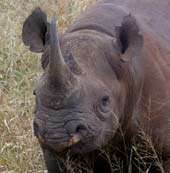West African Black Rhino Extinct, Group Says
 (National Geographic News) The West African black rhinoceros has likely gone extinct, the World Conservation Union (IUCN) announced last week. “The West African black rhino is now feared extinct,” the Switzerland-based environmental group said, and Africa’s northern white rhino could soon follow. Extensive surveys in northern Cameroon (map of Cameroon), the animals’ last known refuge, found no trace of the rhino subspecies.
(National Geographic News) The West African black rhinoceros has likely gone extinct, the World Conservation Union (IUCN) announced last week. “The West African black rhino is now feared extinct,” the Switzerland-based environmental group said, and Africa’s northern white rhino could soon follow. Extensive surveys in northern Cameroon (map of Cameroon), the animals’ last known refuge, found no trace of the rhino subspecies.
Mystech: So long, Diceros bicornis, we barely knew you.
The two rhino species native to Africa, the black and white rhinos, are divided into six subspecies: the northern and southern white rhino and four black rhino subspecies.
IUCN’s announcement suggests a third of Africa’s rhino subspecies are now effectively lost (watch video of a black rhino breeding center in Texas).
Without a Trace
Richard Emslie of IUCN’s Species Survival Commission told BBC News that a trio of experts systematically scoured 1,200 miles (2,500 kilometers) of habitat in northern Cameroon.
The survey failed to find any sign of the West African black rhino.
“They looked for spoor [tracks or droppings], they looked for the rhino’s characteristic way of feeding, which has an effect like a pruning shear,” Emslie, a rhino expert based in KwaZulu-Natal Province, South Africa, told the news service.
“But they didn’t find anything to indicate a continued presence in the area.
“They did, however, come across lots of evidence of poaching, and that’s the disconcerting thing.”
Poachers have hunted the animals for decades for their ivory horns to supply markets in Yemen and Asia (wallpaper: guarding a black rhino).
Rhino horn is used in traditional Asian medicine to fight malaria, epilepsy, fevers, and other ailments. In Yemen the horns are in demand as carved handles on traditional daggers.
IUCN says poachers likely gave the final push that sent the subspecies into oblivion.
Also last week the environmental group reported grim news for Africa’s northern white rhino.
Ground and aerial surveys of the animal’s last known holdout, in Garamba National Park in the Democratic Republic of the Congo (map of the Congo), identified just four animals.
“Efforts to locate further animals continue,” said Martin Brooks of ICUN’s African Rhino Specialist Group.
“But we must now face the possibility that the subspecies may not recover to a viable level.”
Bittersweet Success
The bleak findings contrast with the improving outlook for rhinos elsewhere on the continent.
In southern Africa the southern white rhino has turned into a striking conservation success story, rebounding from fewer than 50 animals a century ago to over 14,000 today.
And the three other black rhino subspecies have increased in number, particularly in South Africa, Namibia, Kenya, and Zimbabwe.
The continent’s total black rhino population gained from a record low of 2,410 in 1995 to 3,725 animals today.
The tally grew 3.5 percent in the past two years alone, according to IUCN.
But those figures still pale in comparison to the rhino’s historic numbers (related wallpaper: black rhino in 1909).
According to some estimates, there were 14,000 black rhinos as recently as 1980 and more than 100,000 in 1960.






